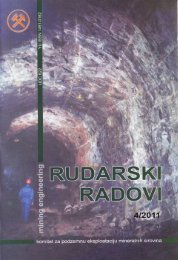Institut za rudarstvo i metalurgiju Bor
Institut za rudarstvo i metalurgiju Bor
Institut za rudarstvo i metalurgiju Bor
Create successful ePaper yourself
Turn your PDF publications into a flip-book with our unique Google optimized e-Paper software.
directly connection to the water level<br />
change in the river. In the period of low<br />
water, the drainage of aquifers is done by<br />
highlighting the river, or stream, or trickling<br />
through the part where alluvial sediments<br />
deposited over the limestone where they<br />
supply the fracture - karst aquifer. Thickness<br />
of gravel and sand range from 0.30 – 2.55 m<br />
and the average of 10 drillhoeles was 1.60<br />
m. In the northern and north-western part of<br />
the open pit “Potrlica”, the inner waste dump<br />
was formed. The roof marls and accompanying<br />
deposits of thickness over 25 m are<br />
dumped. Before dumping, in the space of<br />
the internal dumps, two sources at bench<br />
levels of 708 and 704 m were registered.<br />
Over them, the mined masses were dumped<br />
without drainage, and they affect the aquifer<br />
feeding in the dumped masses, which is<br />
drained over resources in its foot.The estimated<br />
aggregate yield of the source is approximately<br />
10 l/s. The area where the<br />
dumped masses lay over sloping surface of<br />
limestone, the aquifer drainage is also done<br />
in the limestone massif.<br />
Fracture type of aquifer is in the roof<br />
marls but also in the coal layer. Average<br />
thickness of marl is 41 m and maximum<br />
131 m. The marls are bedded and various<br />
fall of 15-48º.The fracture of rocks in the<br />
surface area is larger than the deeper areas.<br />
Marls cover an area of 7 km 2 , which<br />
coincides with the distribution of surface<br />
carbon layer. Aquifer feeding is done by<br />
the infiltration of atmospheric water, infiltration<br />
from alluvion of the river Ćehotina<br />
and infiltration of water from the Triassic<br />
limestone deposits in the rim area (the<br />
accumulation of “Durutovici”). Drainage<br />
of aquifers is leakage from the frontal<br />
prominence of groundwater along the<br />
floor or a concentrated source of contacts<br />
along light gray fractured and dark gray<br />
compact marls as well as on a contact of<br />
the main coal layer and its roof. The yield<br />
zone of sources varies. Mapping registered<br />
multi areas of leakage and expiration<br />
of the highest to the deepest levels of<br />
work in the southern part of the mine yield<br />
of 1 l / s to over 10 l / s. The aquifer in the<br />
marls was released in the free level. The<br />
depth to aquifer is 50-50 m. In the coal<br />
series its thickness is 20 m, where in addition<br />
to the main layers two or three carbon<br />
layers, thickness up to 15 m, the fractured<br />
aquifer was formed. Aquifer was formed<br />
in the part where the actual tectonic fissures<br />
and fault systems are. The main water<br />
supply comes from aquifers from the<br />
eastern and central part of the basin, on<br />
the south of mining front of the open pit<br />
“Potrlica”, where the coal layer lies directly<br />
on limestone. Feeding the aquifers<br />
in the coal is also possible from the roof<br />
marls, but they are weaker sources in the<br />
feeding compared to the karst aquifer.<br />
Karst type of aquifers is in Triassic limestone,<br />
and the space of open pit “Potrlica”<br />
is just a part of large and spatial accumulation<br />
which covers an area of 500 km 2 .<br />
Limestones are substratum of Neogene<br />
deposits throughout the basin, and also<br />
built the northern and eastern edge of the<br />
basin. By prospecting drilling, the limestones<br />
are only bored, and in the majority<br />
of cases the drill holes were ended in the<br />
Neogene, so it is estimated that the thickness<br />
of limestone is several hundred meters,<br />
while the base of karstification is not<br />
clearly defined. The area where the limestone<br />
was discovered, the aquifer is with a<br />
free level. The sources “Tvrdaš” and<br />
“Kutlovača “, the characteristic of karst<br />
was confirmed that the open pit drops to<br />
the next level of outflow. Due to the exploitation<br />
of source “Tvrdaš” and periodical<br />
source “Kutlovača“, the elevation levels<br />
of outflow were dropped from 775.3 m<br />
to 660 m, resulting in an overall lowering<br />
the open pit in the karst aquifer. The area<br />
where the limestone is covered by Neogene,<br />
the open pit is subarteritic. The presence of<br />
karst groundwater is found in every drill<br />
completed in the basin substratum. Groundwater<br />
level oscillations were mild and consistent<br />
with clear influence rainfall. For this area<br />
the average amount of precipitation 795.2<br />
mm/year, and the quantity of most dives and<br />
No 1,2010. 96<br />
MINING ENGINEERING



